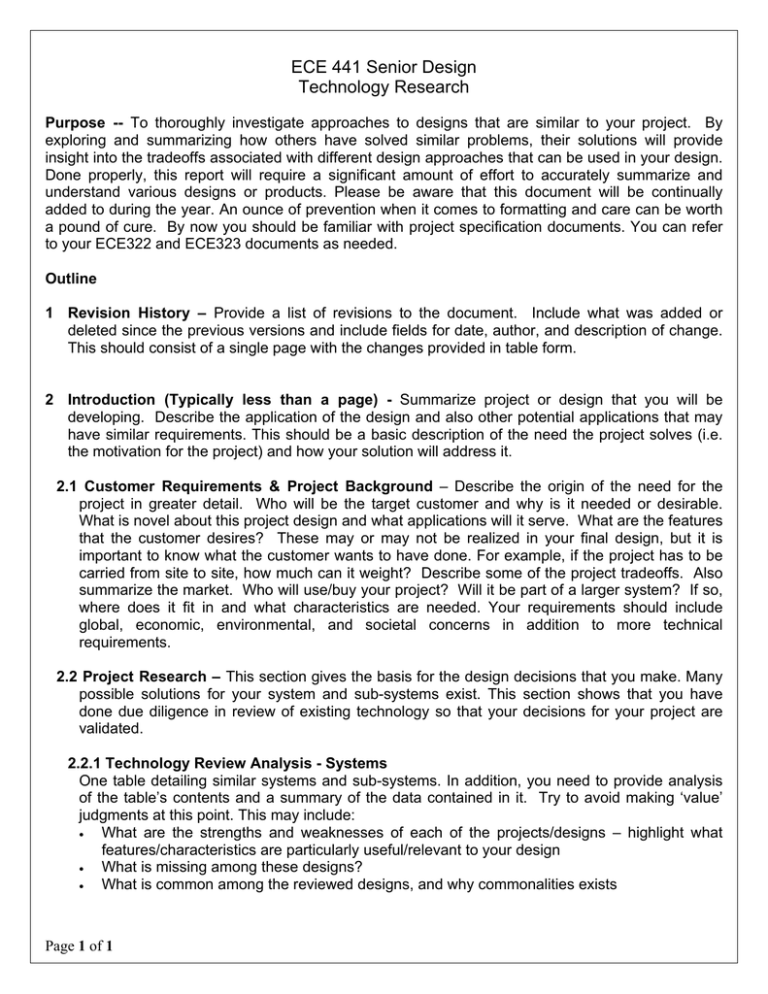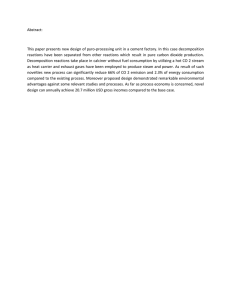ECE 441 Senior Design
advertisement

ECE 441 Senior Design Technology Research Purpose -- To thoroughly investigate approaches to designs that are similar to your project. By exploring and summarizing how others have solved similar problems, their solutions will provide insight into the tradeoffs associated with different design approaches that can be used in your design. Done properly, this report will require a significant amount of effort to accurately summarize and understand various designs or products. Please be aware that this document will be continually added to during the year. An ounce of prevention when it comes to formatting and care can be worth a pound of cure. By now you should be familiar with project specification documents. You can refer to your ECE322 and ECE323 documents as needed. Outline 1 Revision History – Provide a list of revisions to the document. Include what was added or deleted since the previous versions and include fields for date, author, and description of change. This should consist of a single page with the changes provided in table form. 2 Introduction (Typically less than a page) - Summarize project or design that you will be developing. Describe the application of the design and also other potential applications that may have similar requirements. This should be a basic description of the need the project solves (i.e. the motivation for the project) and how your solution will address it. 2.1 Customer Requirements & Project Background – Describe the origin of the need for the project in greater detail. Who will be the target customer and why is it needed or desirable. What is novel about this project design and what applications will it serve. What are the features that the customer desires? These may or may not be realized in your final design, but it is important to know what the customer wants to have done. For example, if the project has to be carried from site to site, how much can it weight? Describe some of the project tradeoffs. Also summarize the market. Who will use/buy your project? Will it be part of a larger system? If so, where does it fit in and what characteristics are needed. Your requirements should include global, economic, environmental, and societal concerns in addition to more technical requirements. 2.2 Project Research – This section gives the basis for the design decisions that you make. Many possible solutions for your system and sub-systems exist. This section shows that you have done due diligence in review of existing technology so that your decisions for your project are validated. 2.2.1 Technology Review Analysis - Systems One table detailing similar systems and sub-systems. In addition, you need to provide analysis of the table’s contents and a summary of the data contained in it. Try to avoid making ‘value’ judgments at this point. This may include: • What are the strengths and weaknesses of each of the projects/designs – highlight what features/characteristics are particularly useful/relevant to your design • What is missing among these designs? • What is common among the reviewed designs, and why commonalities exists Page 1 of 1 2.3 Feature Set 2.3.1 Absolute Minimum Requirements Provide a list of minimum requirements for your design. There should be 7-14 minimum requirements. For each minimum requirement, give a short description. Please keep this section in a bulleted list format, though a short description could be included for each requirement that is ambiguous. 2.3.2 Desired Feature Set This section should detail the list of desirable feature agreed on between you and the course instructor. Please keep this section in a bulleted list format, though a short description could be included for each requirement that is ambiguous. Page 2 of 2 Appendix A. References List technical references used in the preparation including internet sites with information about other projects/designs. Please use IEEE or ASME reference formats Page 3 of 3 Appendix B. Naming Conventions and Glossary Explain any naming conventions used that are not in common usage. Any ambiguous terms that should be explained or defined, but do not fit well into the rest of the report should be defined here. Special attention should be paid to ‘out of discipline’ terms and concepts. The following terms are for your use. You may choose to leave or not leave them in your final document. Block – A block is the basic element of a system. It is a standalone object that performs some function in the system. A block should be ‘small’ enough that everything contained inside of it can be fully understood as a whole, or the contents can be purchased as a whole. Customer Requirement – A requirement that may or may not be able to be tested as is. A requirement supplied by the customer, sponsor, or mentor. Discipline Decomposition – The process of dividing a system into blocks based on the primary knowledge used in defining each block. (e.g. computer science, electrical, mechanical) Engineering Requirements – A requirement that can be tested and evaluated through a step by step process. Usually a numerical specification is included. Environment – The set of influences that the system will be operating within. These could include temperature, humidity, immersion, vacuum, etc… Functional Decomposition – The process of dividing a system into blocks that represent the required functions. See discipline decomposition, locality decomposition Interface Characteristics – Every connection between blocks is defined by a unique name and a list of interface characteristics. These characteristics define an interface to the degree that a block can be built without knowledge of other blocks in the system Locality Decomposition – The process of dividing a system into blocks based on the similarity (locality) of blocks. (e.g. all inputs together, all outputs together) Sub-System – This is a grouping of one or more blocks that function together to perform some task. (e.g. a motor and a motor controller perform the task of motion.) System – The complete system that you are designing. This includes all blocks in your design. Top-Level – This refers to the system block diagram containing all blocks in the system. Page 4 of 4

